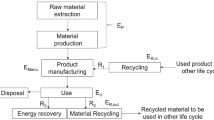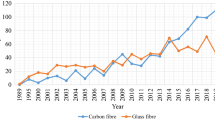Abstract
Carbon fiber-reinforced polymer composites have permeated every aspect of modern life. Significant progress has been made in engineering communities to recycle composite wastes. While emerging recycling techniques can recover both fibers and resins at mild processing conditions, they are currently limited on the laboratory scale. It remains unclear if they could lead to market viability and environmental sustainability when they are used for industrial applications; if not, what the limiting factors are and how to improve them. In this study, the environmental and economic impacts of existing recycling techniques are studied. The average recycling costs are analyzed, and the environmental impacts are examined. It reveals that while the emerging techniques can recycle composites with extremely low environmental impact, their costs are significant compared to conventional techniques, primarily due to the expensive solvents and catalysts used to enable recycling. However, the study shows that it is possible to combine conventional waste processing techniques with emerging ones to enable recycling scenarios that are both cost-effective and environmentally beneficial. Overall, the study in this paper provides valuable insights for the design of future waste management supply chains and appropriate business models for the sustainable development of society.
Graphical abstract







Similar content being viewed by others
Data availability
The datasets generated during and/or analyzed during the current study are available from the corresponding author on reasonable request.
References
Abdallah R, Juaidi A, Savas MA, Camur H, Albatayneh A, Abdala S, Manzano-Agugliaro F (2021) A critical review on recycling composite waste using pyrolysis for sustainable development. Energies 14(18):5748
Azapagic A, A Emsley and L Hamerton (2003) Polymers, the Environment and Sustainable Development. John Wiley and Sons, Ltd.: ISBNs: 0–471–87740–87749
Chung D (2012 ) Carbon Fiber Composites. Butterworth-Heinemann
Conroy A, Halliwell S, Reynolds T (2006) Composite recycling in the construction industry. Compos Part A-Appl Sci Manuf 37(8):1216–1222
Dong PAV, Azzaro-Pantel C, Cadene A-L (2018) Economic and environmental assessment of recovery and disposal pathways for CFRP waste management. Resour Conserv Recycl 133:63–75
Gopalraj SK, Kärki T (2020) A review on the recycling of waste carbon fibre/glass fibre-reinforced composites: fibre recovery, properties and life-cycle analysis. SN Appl Sci 2:433
Hedlund-Åström A (2005) Model for end of life treatment of polymer composite materials. KTH, Stockholm
Howarth J, Mareddy SSR, Mativenga PT (2014) Energy intensity and environmental analysis of mechanical recycling of carbon fibre composite. J Clean Prod 81:46–50
Jiang G, Pickering SJ, Walker GS, Bowering N, Wong KH, Rudd CD (2007) Soft ionisation analysis of evolved gas for oxidative decomposition of an epoxy resin/carbon fibre composite. Thermochim Acta 454(2):109–115
Jody BJ, Pomykala JA, Daniels EJ, Paulauskas F, Abdallah MG (2004) A process to recover carbon fibres from polymer matrix composite scrap. Int SAMPE Symp Exhib 49:35–47
Johnson LM, Ledet E, Huffman ND, Swarner SL, Shepherd SD, Durham PG, Rothrock GD (2015) Controlled degradation of disulfide-based epoxy thermosets for extreme environments. Polymer 64:84–92
Knight CC, Zeng C, Zhang C, Wang B (2012) Recycling of woven carbon-fibre-reinforced polymer composites using supercritical water. Environ Technol 33:639–644
Knight CC (2013) Recycling high-performance carbon fiber reinforced polymer composites using sub-critical and supercritical water. Florida State University
Krawczak P (2012) Recyclage des composites. Tech Ing Plasturgie Procédés Spécifiques Aux Compos base documentaire: TIB474DUO
Kuang X, Zhou Y, Shi Q, Wang T, Qi HJ (2018) Recycling of epoxy thermoset and composites via good solvent assisted and small molecules participated exchange reactions. ACS Sustain Chem Eng 6(7):9189–9197
La Rosa AD, Banatao DR, Pastine SJ, Latteri A, Cicala G (2016) Recycling treatment of carbon fibre/epoxy composites: materials recovery and characterization and environmental impacts through life cycle assessment. Compos Part B-Eng 104:17–25
Li X, Bai R, McKechnie J (2016) Environmental and financial performance of mechanical recycling of carbon fibre reinforced polymers and comparison with conventional disposal routes. J Clean Prod 127:451–460
Liu YY, Meng LH, Huang YD, Du JJ (2004) Recycling of carbon/epoxy composites. J Appl Polym Sci 94(5):1912–1916
Liu T, Zhang M, Guo XL, Liu CY, Liu T, Xin JN, Zhang JW (2017) Mild chemical recycling of aerospace fiber/epoxy composite wastes and utilization of the decomposed resin. Polym Degrad Stab 139:20–27
Luzuriaga AR, Martin R, Markaide N, Rekondo A, Cabañero G, Rodrígueza J, Odriozola I (2016) Epoxy resin with exchangeable disulfide crosslinks to obtain reprocessable, repairable and recyclable fiber-reinforced thermoset composites. Mater Horiz 3:241–247
Ma S, Webster DC (2018) Degradable thermosets based on labile bonds or linkages: a review. Prog Polym Sci 76:65–110
McConnell VP (2010) Launching the carbon fibre recycling industry. Reinf Plast 54(2):33–37
Meng F, Olivetti EA, Zhao Y, Chang JC, Pickering SJ, McKechnie J (2018) Comparing life cycle energy and global warming potential of carbon fibre composite recycling technologies and waste management options. ACS Sustain Chem Eng 6(8):9854–9865
Pinero-Hernanz R, Dodds C, Hyde J, Garcia-Serna J, Poliakoff M, Lester E, Cocero MJ, Kingman S, Pickering S, Wong KH (2008) Chemical recycling of carbon fibre reinforced composites in nearcritical and supercritical water. Compos Part A-Appl Sci Manuf 39(3):454–461
Rush S (2007) Carbon fiber: life beyond the landfil. High-Perform Compos 15(3):52–55
Takahashi A, Ohishi T, Goseki R, Otsuka H (2016) Degradable epoxy resins prepared from diepoxide monomer with dynamic covalent disulfide linkage. Polymer 82:319–326
Taynton P, Ni HG, Zhu CP, Yu K, Loob S, Jin YH, Qi HJ, Zhang W (2016) Repairable woven carbon fiber composites with full recyclability enabled by malleable polyimine networks. Adv Mater 28(15):2904–2909
Wang YQ, Cui XJ, Yang QQ, Deng TS, Wang YX, Yang YX, Jia SY, Qin ZF, Hou XL (2015) Chemical recycling of unsaturated polyester resin and its composites via selective cleavage of the ester bond. Green Chem 17(9):4527–4532
Witik RA, Teuscher R, Michaud V, Ludwig C, Månson J-AE (2013) Carbon fibre reinforced composite waste: an environmental assessment of recycling, energy recovery and landfilling. Compos A Appl Sci Manuf 49:89–99
Yip HLH, Pickering SJ, Rudd CD (2002) Characterisation of carbon fibres recycled from scrap composites using fluidised bed process. Plast Rubber Compos 31(6):278–282
Funding
The authors acknowledge support from Fundamental Research Funds for Heilongjiang Provincial Undergraduate Universities (2019BJ08) and Funds for Science and Technology Innovation Team at Heilongjiang Institute of Technology (2018cx15).
Author information
Authors and Affiliations
Contributions
XJ contributes to the conceptualization, methodology, analysis, and investigation of this study. The first draft of the manuscript was written by XJ. All authors commented on previous versions of the manuscript. All authors read and approved the final manuscript.
Corresponding author
Ethics declarations
Conflict of interest
The author has no relevant financial or non-financial interests to disclose.
Additional information
Publisher's Note
Springer Nature remains neutral with regard to jurisdictional claims in published maps and institutional affiliations.
Rights and permissions
Springer Nature or its licensor (e.g. a society or other partner) holds exclusive rights to this article under a publishing agreement with the author(s) or other rightsholder(s); author self-archiving of the accepted manuscript version of this article is solely governed by the terms of such publishing agreement and applicable law.
About this article
Cite this article
Jiang, X., Shao, M. & Bateer, B. Economic and environmental analysis of composite recycling techniques for the design of future waste management supply chains. Clean Techn Environ Policy 25, 1659–1671 (2023). https://doi.org/10.1007/s10098-022-02462-3
Received:
Accepted:
Published:
Issue Date:
DOI: https://doi.org/10.1007/s10098-022-02462-3




